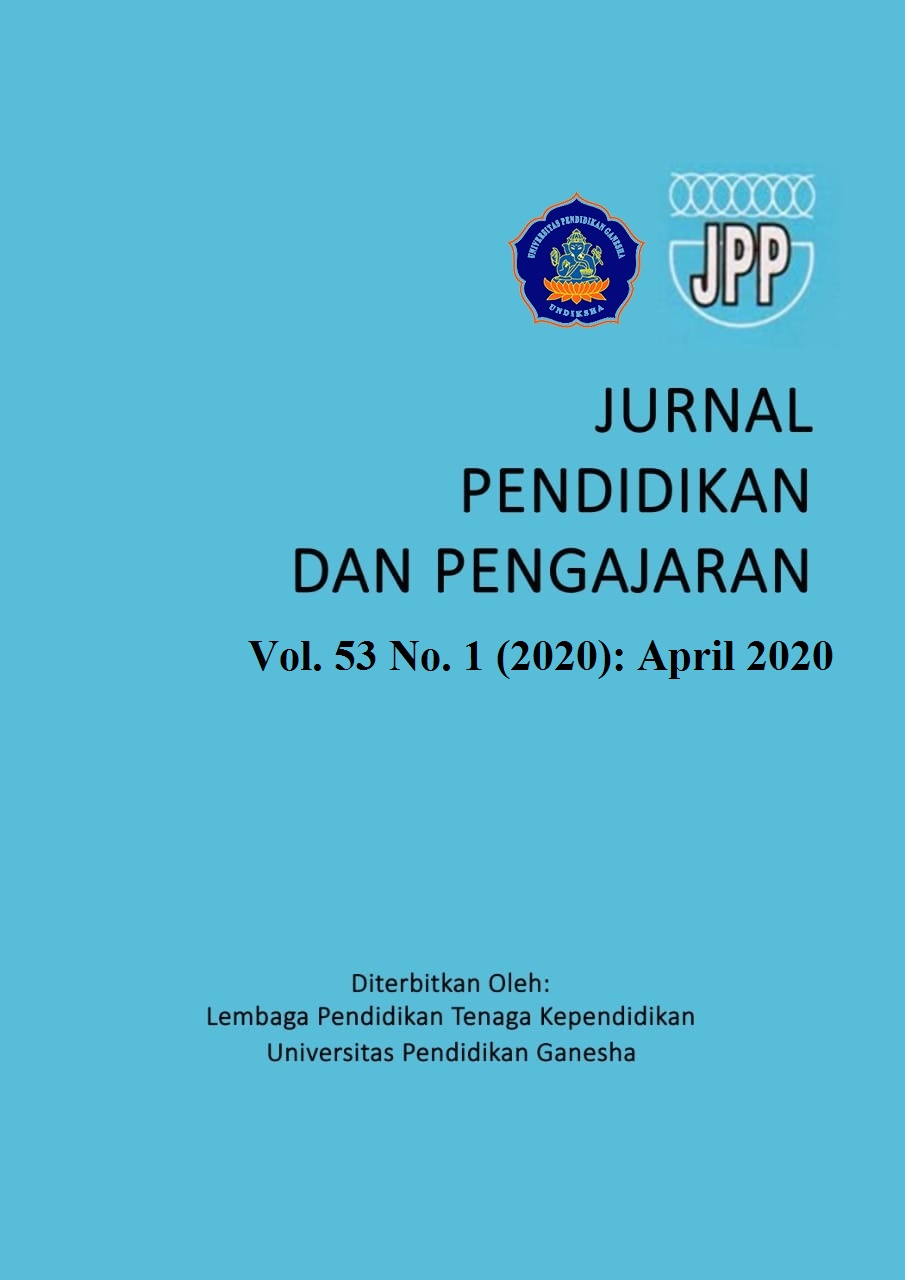Camtasia as English Learning Video in EFL Classroom: Response of its Implementation
DOI:
https://doi.org/10.23887/jpp.v53i1.19051Keywords:
Camtasia, English learning video, response, young learnersAbstract
Since Educational industry 4.0 reflects the current style of teaching and learning process, the integration of technology-based learning media has been highly demanded. Thus, various types of learning media including video have been widely implemented. This policy was then the basis of this present study to describe teachers’ and students’ response towards the implementation of animated learning video developed by using Camtasia in elementary schools. This study made use of a descriptive qualitative study. The data were collected through observation, questionnaire, and interviews. The result of this study clearly indicates that by offering animated learning video, the learning activity becomes more attractive even more affects the students’ understanding, especially in building vocabulary mastery. As the result, the animated learning video developed has been acknowledged as an effective learning media. As the advantage, this study can enrich students’ learning experience in learning English.
References
Akerele, J.A., Adeola, F.A (2012). “Effect of video on the teaching of library studies among undergraduates in adeyemi college of education ondo”. Library Philosophy and Practice 2012. Retrieved from http://unllib.unl.edu/LPP/
Arfiyanti, R., Nuryanti, M., Widodo, S. A., & Arigiyati, T. A. (2018). Camtasia studio learning video for mathematical literature levels students. https://doi.org/10.4108/eai.21-9-2018.2281180
Anggraeni, C. W. (2018). Promoting education 4. 0 in English for survival class : What are the Challenges ?, 2(1), 12–24. https://doi.org/10.31002/metathesis.v1i2.676
Bauk, S., & Radlinger, R. (2013). Teaching ECDIS by camtasia studio : making the content more engaging, 7(3). https://doi.org/10.12716/1001.07.03.08
Ciputra, A. (2014). Development of media camtasia studio on learning outcomes computer aided design automotive engineering student at purworejo muhammadiyah university.
Gilakjani, A. P., & Branch, L. (2012). Visual, auditory, kinaesthetic learning styles and their impacts on english language teaching, 2(1), 104–113.
Heilesen, Simon B. (2009). "Om erfaringer med podcasts i universiteternes undervisning" Læring og medier 2: http://ojs.statsbiblioteket.dk/index.php/lom/article/view/3909
Miller, C. J. (2014). The use of novel camtasia videos to improve performance of at-risk students in undergraduate physiology courses. World Journal of Education, 4(1), 22–n/a. https://doi.org/10.5430/wje.v4n1p22
Muhanna, W. (2018). Using camtasia videos in assigned projects for middle east university students and their attitudes towards it, 8(11), 75–82. https://doi.org/10.30845/ijhss. v8n11p
Nuari, F., Ardi, H., & M.Hum. (2014). Using camtasia studio 8 to produce learning video to teach English through e-learning. Jelt, 3(September), 1–9. https://doi.org/http:// dx.doi.org/10.1016/0378-4266(81)90050-9
Pappas, I. O., Mikalef, P., & Giannakos, M. N. (2016, 2016). Video-based learning adoption: a typology of learners. paper presented at the proceedings of the workshop on smart environments and analytics in video-based learning (SE@VBL), LAK2016.
Pramudito, A. (2013). "Pengembangan Media Pembelajaran Video Tutorial Pada Mata Pelajaran Kompetensi Kejuruan Standar Kompetensi Melakukan Pekerjaan dengan Mesin Bubut di SMK Muhammadiyah 1 Playen". Jurnal Pendidikan Teknik Mesin. Hal. 4. Retrieved from http://eprints.uny.ac.id/10393/1/JurnalPenelitian.pdf
Puncreobutr, V. (2018). Education 4.0: New challenge of learning. St. Theresa Journal of Humanities and Social Science, 2(2), 92-97. Retrieved from http://www.stic.ac.th/ojs/
Rahayu, F., S. (2013). "Efektifitas Model Pembelajaran Contextual Teaching and Learning (CTL) Berbantuan Power Point, Macromedia Flash, dan Video Pembelajaran Terhadap Hasil Belajar Matematika Siswa Pada Materi Kubus dan Balok Kelas VIII Semester 2 SMP Negeri Karang Tengah Demak Tahun Pelajaran 2012/2013". Unpublished Thesis Semarang. Retrieved from http://library.ikippgrismg.ac.id/%20docfiles/
Retno, Eli Widoyo., Mardiyana. dan Tri Atmojo Kusmayadi. (2014). Pengembangan model pembelajaran group investigation (gi) berbantu video camtasia pada materi peluang untuk siswa sma/ma negeri kabupaten cilacap tahun pelajaran 2013/2014. Jurnal Elektronik Pembelajaran Matematika. Vol.2, No.5.
Saigh, W. (2015). The attitudes of master educational technology students at king abdul-aziz university towards using camtasia videos in assigned projects. Global Research Journal of Education , 415-422.
Setyorini, Evi Sulis., Isna Tiyaswati., Lisa Faradilla., Rinta Dian Pratiwi. (2016). Pembuatan video pembelajaran menggunakan camtasia studio 7 sebagai media pembelajaran fisika pada materi hukum newton. Seminar Nasional Pendidikan dan Saintek 2016. ISSN: 2557-533X.
Wang, Zhaogang. (2015). An analysis on the use of video materials in college English teaching in china. International Journal of English Language Teaching Vol. 2, No. 1;2015. ISSN 2329-7913 E-ISSN 2329-7921. Retrieved from http://puslit.petra.ac.id/ejournal/ index.php/ing/article/view/15498
Downloads
Published
How to Cite
Issue
Section
License
Authors who publish with Jurnal Pendidikan dan Pengajaran agree to the following terms:- Authors retain copyright and grant the journal the right of first publication with the work simultaneously licensed under a Creative Commons Attribution License (CC BY-SA 4.0) that allows others to share the work with an acknowledgment of the work's authorship and initial publication in this journal
- Authors are able to enter into separate, additional contractual arrangements for the non-exclusive distribution of the journal's published version of the work (e.g., post it to an institutional repository or publish it in a book), with an acknowledgment of its initial publication in this journal.
- Authors are permitted and encouraged to post their work online (e.g., in institutional repositories or on their website) prior to and during the submission process, as it can lead to productive exchanges, as well as earlier and greater citation of published work. (See The Effect of Open Access)





